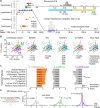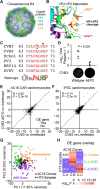This is a preprint.
Three Modes of Viral Adaption by the Heart
- PMID: 38585853
- PMCID: PMC10996681
- DOI: 10.1101/2024.03.28.587274
Three Modes of Viral Adaption by the Heart
Update in
-
Three modes of viral adaption by the heart.Sci Adv. 2024 Nov 15;10(46):eadp6303. doi: 10.1126/sciadv.adp6303. Epub 2024 Nov 13. Sci Adv. 2024. PMID: 39536108 Free PMC article.
Abstract
Viruses elicit long-term adaptive responses in the tissues they infect. Understanding viral adaptions in humans is difficult in organs such as the heart, where primary infected material is not routinely collected. In search of asymptomatic infections with accompanying host adaptions, we mined for cardio-pathogenic viruses in the unaligned reads of nearly one thousand human hearts profiled by RNA sequencing. Among virus-positive cases (~20%), we identified three robust adaptions in the host transcriptome related to inflammatory NFκB signaling and post-transcriptional regulation by the p38-MK2 pathway. The adaptions are not determined by the infecting virus, and they recur in infections of human or animal hearts and cultured cardiomyocytes. Adaptions switch states when NFκB or p38-MK2 are perturbed in cells engineered for chronic infection by the cardio-pathogenic virus, coxsackievirus B3. Stratifying viral responses into reversible adaptions adds a targetable systems-level simplification for infections of the heart and perhaps other organs.
Conflict of interest statement
Competing interests: The authors declare that they have no competing interests.
Figures






References
-
- Kuhl U. et al., Viral persistence in the myocardium is associated with progressive cardiac dysfunction. Circulation 112, 1965–1970 (2005). - PubMed
-
- Why H. J. et al., Clinical and prognostic significance of detection of enteroviral RNA in the myocardium of patients with myocarditis or dilated cardiomyopathy. Circulation 89, 2582–2589 (1994). - PubMed
-
- Pankuweit S., Klingel K., Viral myocarditis: from experimental models to molecular diagnosis in patients. Heart Fail. Rev. 18, 683–702 (2013). - PubMed
-
- Abdel-Aty H. et al., Diagnostic performance of cardiovascular magnetic resonance in patients with suspected acute myocarditis: comparison of different approaches. J. Am. Coll. Cardiol. 45, 1815–1822 (2005). - PubMed
Publication types
Grants and funding
LinkOut - more resources
Full Text Sources
Research Materials
